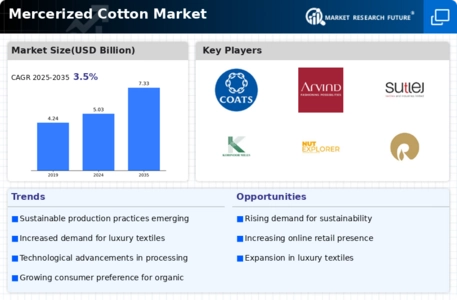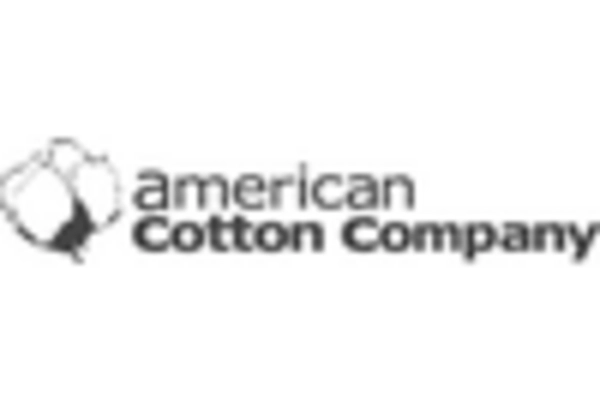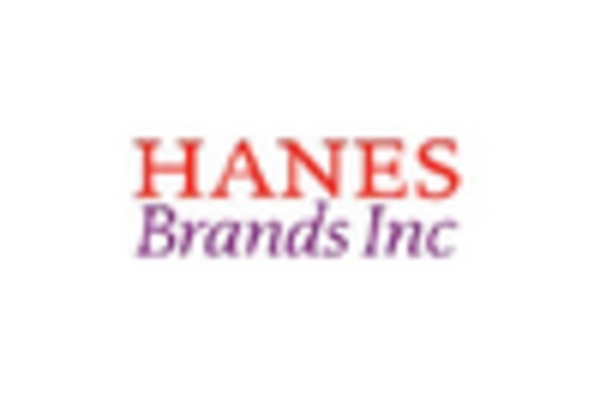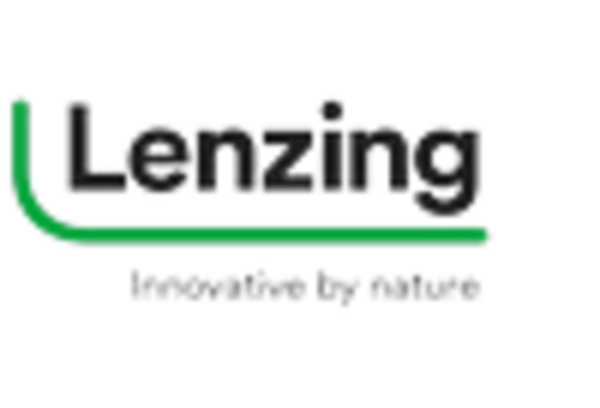Sustainability Trends
The increasing emphasis on sustainability appears to be a pivotal driver in the Mercerized Cotton Market. Consumers are becoming more environmentally conscious, leading to a heightened demand for sustainable textiles. Mercerized cotton, known for its enhanced durability and luster, aligns well with these sustainability initiatives. In 2025, the market for sustainable textiles is projected to reach approximately 200 billion USD, indicating a robust growth trajectory. This trend suggests that manufacturers focusing on eco-friendly practices may gain a competitive edge. Furthermore, brands that incorporate sustainable materials into their product lines are likely to attract a more discerning customer base, thereby enhancing their market share within the Mercerized Cotton Market.
Fashion Industry Dynamics
The evolving dynamics of the fashion industry are poised to impact the Mercerized Cotton Market. As fashion trends shift towards more sustainable and high-quality materials, mercerized cotton is likely to gain prominence. Designers and brands are increasingly seeking fabrics that not only offer aesthetic appeal but also durability and comfort. In 2025, the demand for mercerized cotton in high-end fashion is expected to rise, driven by consumer preferences for luxury and quality. This trend indicates that the Mercerized Cotton Market may experience growth as fashion houses incorporate mercerized cotton into their collections, appealing to a market segment that values both style and substance.
Rising Disposable Incomes
The rise in disposable incomes across various regions is likely to bolster the Mercerized Cotton Market. As consumers experience increased financial freedom, their purchasing power expands, allowing for greater expenditure on premium textile products. Mercerized cotton, often associated with luxury and quality, stands to benefit from this trend. In 2025, it is anticipated that the global middle class will grow significantly, leading to a surge in demand for high-quality cotton products. This demographic shift suggests that brands offering mercerized cotton may see a substantial increase in sales, as consumers prioritize quality and durability in their textile choices. Thus, the Mercerized Cotton Market could witness a favorable shift in consumer preferences.
Health and Wellness Trends
The growing focus on health and wellness is emerging as a notable driver in the Mercerized Cotton Market. Consumers are increasingly aware of the materials used in their clothing, seeking fabrics that are not only comfortable but also hypoallergenic and breathable. Mercerized cotton, with its smooth texture and enhanced properties, aligns well with these health-conscious preferences. In 2025, the market for health-oriented textiles is projected to expand, suggesting that consumers are willing to invest in quality fabrics that promote well-being. This trend indicates that manufacturers of mercerized cotton may find new opportunities to cater to a health-conscious audience, thereby enhancing their position within the Mercerized Cotton Market.
Technological Advancements
Technological innovations in textile manufacturing are significantly influencing the Mercerized Cotton Market. Advanced processing techniques, such as improved mercerization methods, enhance the quality and performance of cotton fibers. These advancements not only increase the strength and dye affinity of cotton but also reduce production costs. As of 2025, the adoption of automation and smart technologies in textile production is expected to rise, potentially leading to a more efficient supply chain. This could result in lower prices for consumers and increased accessibility of mercerized cotton products. Consequently, manufacturers that invest in technology may experience enhanced productivity and profitability within the Mercerized Cotton Market.


















Leave a Comment